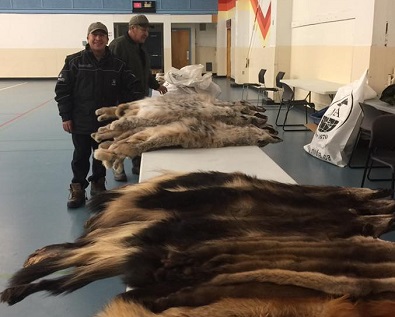A trappers table in Prince Albert in 2016. Photo courtesy the Northern Saskatchewan Trappers Association.
Provincial fur expert Mike Gollop says there is reason to be optimistic about the fur trade in Saskatchewan.
The latest report from Saskatchewan Environment shows a big increase in prices and a better return for trappers.
Overall sales for the last fiscal year totaled $3.5 million, with coyote pelts bringing in 77 per cent of that total.
Prices were also up right across the board ranging from nine per cent to more than 60 per cent, depending on the pelt.
Gollop, who is the ministry’s fur program administrator, says the marten market — which is big in northern Saskatchewan — saw a 54 per cent increase, pushing the average price of a pelt to $99.01.
“You know, when you start to get around the 100-dollar mark, you are talking some pretty good highs for a long term average,” he says. “So that will attract some attention, and there were a lot of martens taken in.”
A total of 4,165 martens were harvested during the last trapping season, bringing in a total $412,376. It was the second-highest dollar value of the season.
Coyotes were, by far, the biggest money maker, bringing in $2.7 million. Average coyote pelt prices were also up 34 per cent to $111.00. A total of 24,830 coyotes were taken during the last trapping season.
The total animal harvest for the last trapping season was roughly 64,000 animals, made up mainly of coyote and muskrat.
Muskrat prices hit $3.42, a 57 per cent jump from the previous year.
The number of animals harvested was down 28 per cent from the previous year. Gollop attributes that to low prices for species like squirrel and weasel, with many trappers just not bothering.
Meanwhile, 4,534 trapper licenses were issued, down from 4,990 the previous year. License fee increases are blamed for the drop, according to Gollop, with casual trappers deciding to opt out.
The 2016-17 Wild Fur Market Harvest and Cash Values report was published on Saskatchewan Environment’s website this week.
